15 Armenian Recipes to Introduce You to the Vibrant Cuisine
This introduction to Armenian cuisine includes celebratory dishes and simple, everyday staples.
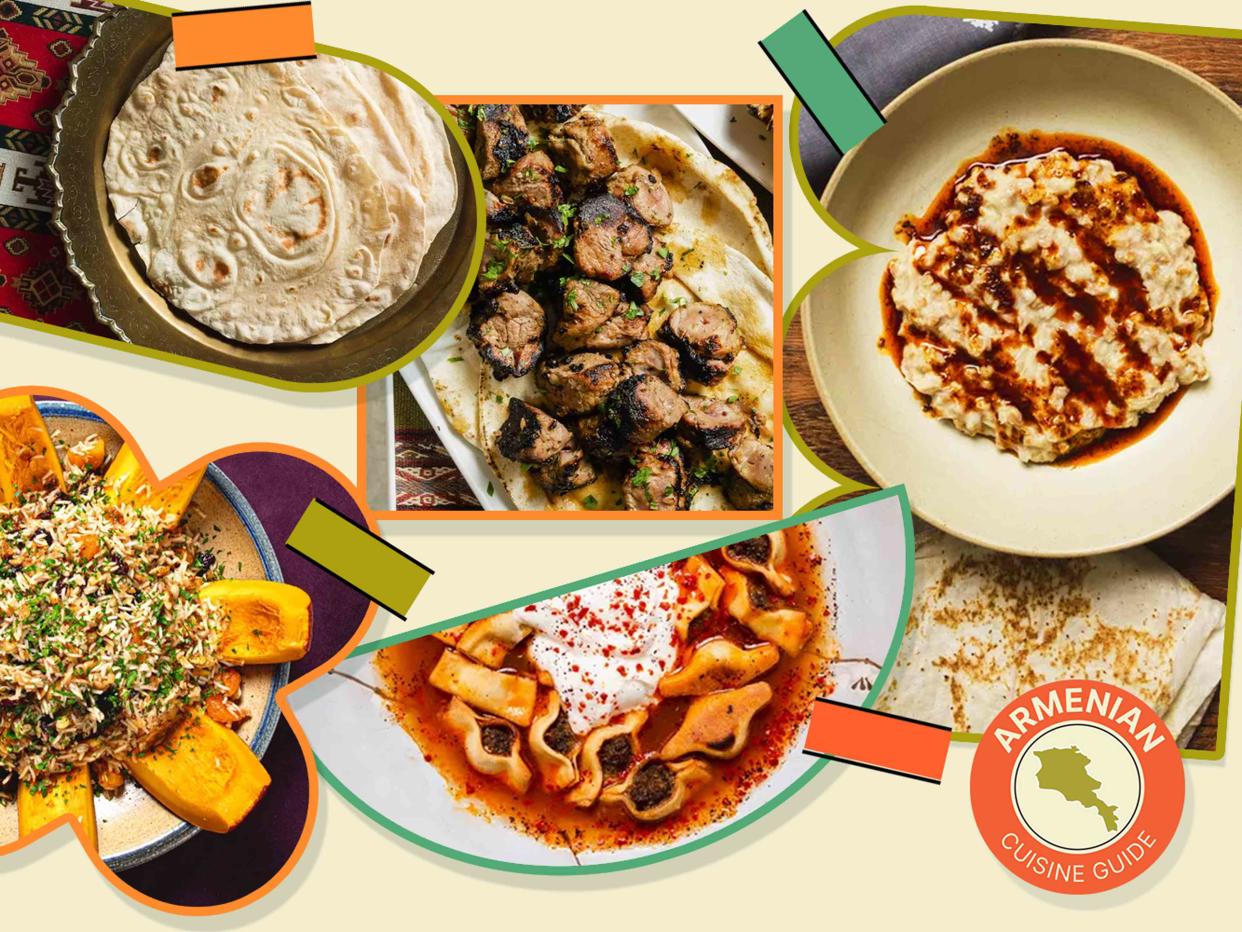
Serious Eats / Andrew Janjigian
Armenian food is a study in contrasts: indulgent and celebratory on one hand, and humble and nourishing on the other. Historical Armenia, which includes the current-day Armenian Republic along with much of what is now part of Eastern Turkey, was a mountainous, isolated, and relatively poor region. With limited access to the outside world, Armenians learned to make do with what they had, particularly during their long winters. Armenians were (and many remain) a very religious people (it is a point of pride for many that the Kingdom of Armenia was the first nation to make Christianity its state religion, way back in 303 AD). Not only was meat a precious resource, but it was also forbidden by the church for nearly half of the calendar year, both during the forty days of lent and some 120 other fast days outside of it. As a result, they developed a sophisticated vegetarian cuisine, with beans, lentils, nuts, and dairy products like yogurt and cheese standing in for meat.
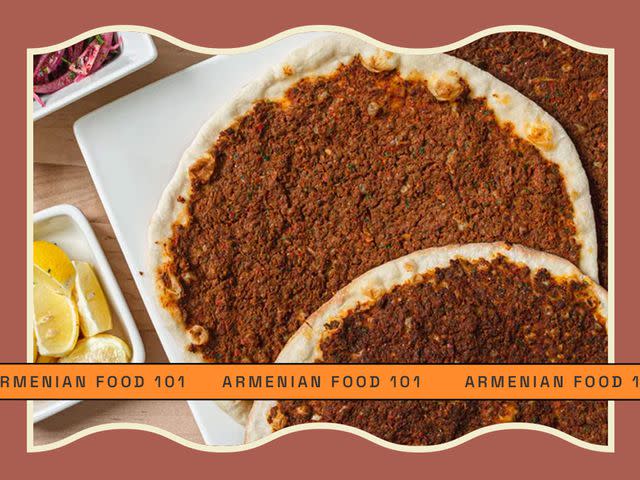
Serious Eats / Andrew Janjigian
With that said, Armenians are all-in on feasting during times of plenty or at the end of fasting periods. (Holiday gatherings in my family are studies in excess, with most guests full to the brim long before the main courses appear.) My family, and many other Armenians, love meat, especially lamb: Cooks grill it over charcoal on skewers, braise it in stews and soups, turn it into meatballs, and even serve it raw. And they are especially fond of sweets, whether it’s the fruits abundant within their region—grapes, pomegranate, peaches, and apricots, among others—or desserts and breads containing copious quantities of sugar.
Read More: How to Stock an Armenian Pantry
The following is a list of some of the most iconic and beloved dishes of the Armenia diaspora. Some of these recipes, like fassoulia, rice pilaf, and dolma, may be familiar, as versions of them feature in other Southwest Asian cuisines. Below, you’ll find celebratory dishes, as well as simple, everyday staples. With the exception of a few recipes, I grew up eating these dishes regularly. The rest are those I’ve come to love through experimenting and exploring them in my own kitchen—and I hope you will, too.
Choreg (Armenian Easter Bread)
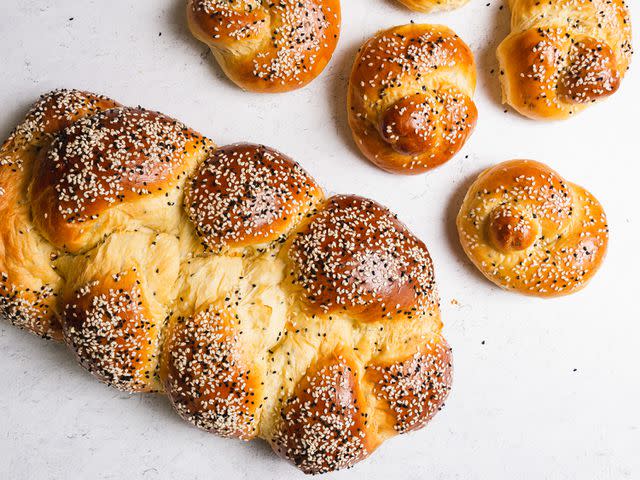
Perhaps no Armenian dish is more representative of the Armenian tendency for extravagance than choreg, a sweet bread essential to the Easter table, though it is served year-round as well. Choreg is essentially brioche—an enriched bread made from milk, eggs, butter, and sugar—but far sweeter, and scented with two spices beloved by Armenians: nigella and mahlab. Bakers shape choreg into round or knotted rolls, or into long braids, with three strands meant to represent the Holy Trinity. Choreg is also made in Greece (where it is called tsoureki and is flavored with piney mastic instead of mahlab), Turkey (paskalya çöreği), and Eastern Europe, though its flavors and shapes vary widely.
Lavash (Armenian Flatbread)
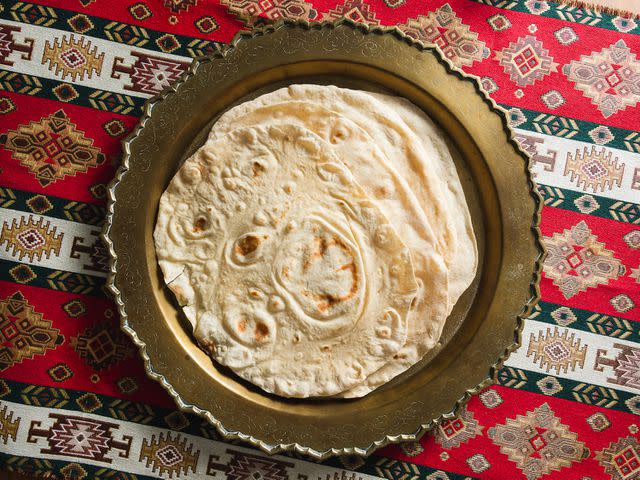
Andrew Janjigian
After choreg, the bread Armenians consider essential and most reflective of their cultural heritage is lavash. And unlike choreg, lavash is simple and humble, made with just flour, water, salt, and yeast (and sometimes even without yeast). The dough is stretched, rolled, and slapped into paper-thin sheets many feet long and wide, laid over a pillow-like convex cushion, which is used to transfer the bread to the walls of a tonir, a deep, wood-fired oven, where it cooks in a matter of seconds. Some lavash is made unleavened, though most are leavened using an “old dough" method: Similar to sourdough, a small portion of each batch of dough is reserved to start the next one.
While lavash is eaten fresh, it’s just as often allowed to dry—laid flat on racks or rolled into cigars—until crisp, so it can be preserved for the long winter. The thin bread keeps well once dried, and many eat it like a cracker or rehydrate it by soaking or sprinkling it with water.
Making lavash at home without a tonir requires a different set of techniques, but it’s not hard to do. And like pita, fresh lavash is loads better than most of what’s available in stores, and well worth the time and effort. It has a tender, melt-in-your-mouth texture and a clean, wheaty flavor that gets masked by the fats and fillers commercial lavash producers add to keep the bread soft while it sits on supermarket shelves.
Like pita, lavash is used as a scoop for dips like hummus and muhammara, as a wrapper for meats, cheeses, or pickles as a mezze snack, or to make larger wrap-like sandwiches. It can also be used as a phyllo-like wrapper for turnovers, as in this recipe for lavash triangles.
Lahmajun (Armenian Flatbread With Spiced Lamb)
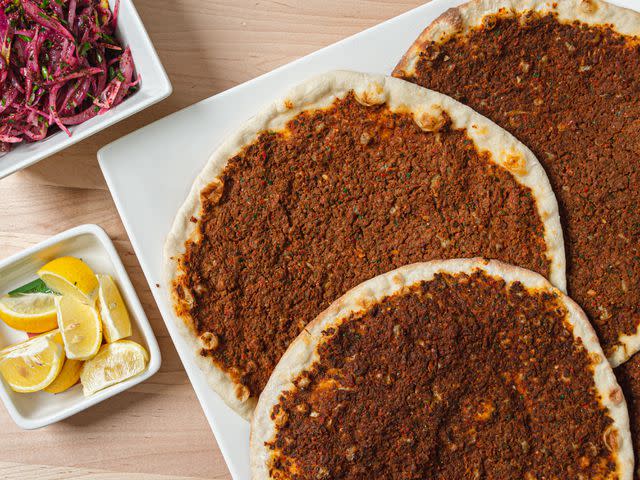
Serious Eats / Andrew Janjigian
It’s easy to see why lahmajun gets called “Armenian pizza” by non-Armenians all the time: It’s a crisp, thin flatbread with an aromatic, bright red topping. Unlike tomato and cheese pizza, however, lahmajun is topped with a very thin layer of ground meat (lamb or beef), heavily seasoned with red-pepper and tomato pastes, fresh onion, garlic, red pepper, parsley, and warm spices. The fresh vegetables are ground to a smooth paste and drained of excess moisture, giving the topping a texture closer to a paste than a sauce. It’s less like a pizza than an open-faced ground meat kofta sandwich—in fact, it’s often eaten rolled up with a chopped, crisp salad on the inside, just like a sandwich.
(For a non-traditional but actual Armenian pizza, see my recipe for ”Armenian" Pizza With Spiced Lamb Sausage, Armenian String Cheese, and Sumac.)
Armenian Rice Pilaf
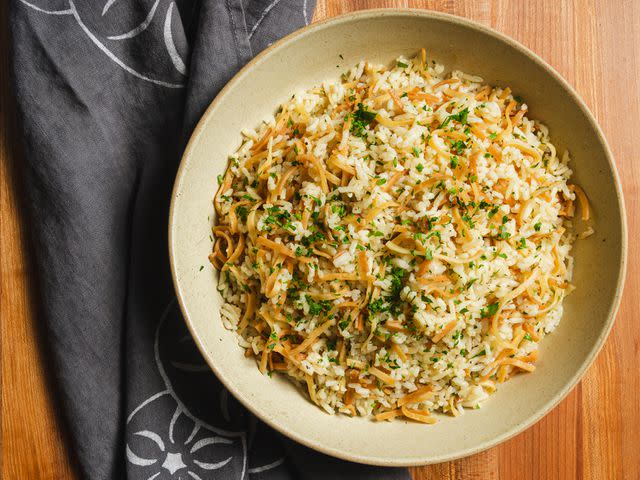
Serious Eats / Andrew Janjigian
Rice pilaf—long-grain white rice and a fistful of pasta toasted in butter and simmered with chicken stock—is absolutely fundamental to the cuisine of the Armenian diaspora. In Eastern Armenia, the region that is now the Armenian Republic, rice wasn’t commonly eaten until relatively recently. But for those whose ancestors emigrated from Western Armenia (mine among them), rice pilaf is so essential that it is served with most meals, even those where other starches are present. (Just try talking my mother out of adding pilaf to an already-full table—it’s a fool’s errand.) For most in the Armenian diaspora, it’s not a meal unless rice pilaf is included.
Most Americans know Armenian-style rice pilaf thanks to Rice-a-Roni, the boxed product that popularized rice in the U.S. during the 1950s. (In 2008, NPR’s The Kitchen Sisters shared the tale of how an Italian-American pasta company taught Americans to love rice thanks to a chance encounter between a Canadian immigrant and an Armenian Genocide survivor.) While Rice-a-Roni brought the dish into the homes and consciousness of so many non-Armenians, homemade rice pilaf is far superior to anything that comes in a box. Plus: It’s so easy and quick to make that it’s practically a convenience food.
Khorovats (Armenian Shish Kebabs)
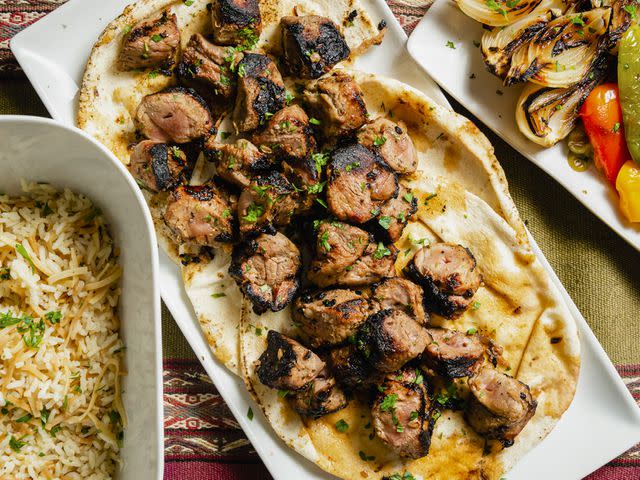
Serious Eats / Andrew Janjigian
After rice pilaf, grilled meats are perhaps the food most fundamental to Armenian cuisine, and the go-to centerpiece of feasts, provided the weather is warm enough to fire up the grill. (Some Armenians refer to barbecued meats as khorovats, or “grilled,” but in my family we just call them kebabs.)
Armenian kebabs come in two styles, both grilled and usually served side-by-side. The first, shish kebabs, refers to skewered hunks of beef or lamb (the word “shish” is the English rendering of the Turkish word şiş, meaning sword or skewer). The second, losh kebabs, are seasoned ground meat patties cooked without skewers.
Shish kebabs can be made from either lamb or beef. My family always makes them from leg of lamb, trimmed and broken down into one-inch pieces that can be skewered easily. The meat is then marinated with chopped onions, tomato paste, red wine, salt, and pepper, and refrigerated overnight. The flavor of shish kebab is mostly that of fire-charred meat, and its simple marinade seasons the meat throughout while also adding sugars to promote caramelization on the grill.
Losh Kebabs (Armenian Grilled Meat Patties)
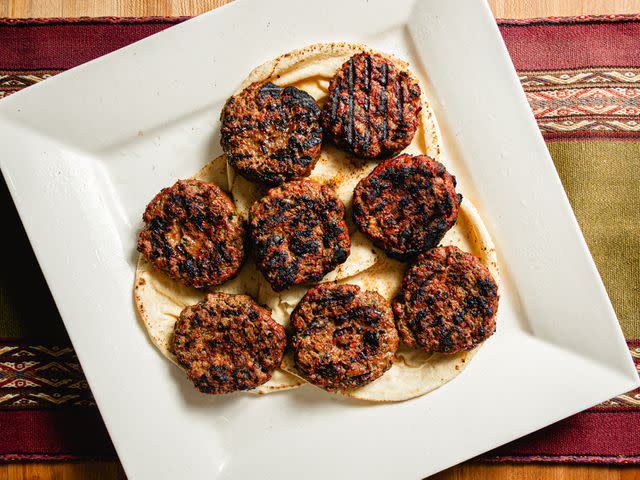
Serious Eats / Andrew Janjigian
Armenian grilled, spiced ground meat kebabs go by a few different names, depending on how they are shaped and grilled. Regardless of shape, the meat mixture and seasonings are essentially the same. Lula or lule kebabs (“lule” means “rolled”) are formed into sausage-shaped logs—skewered or freeform—or into long, flat patties by pressing them onto special flat, sword-like skewers.
In New England, where I grew up, Armenians make losh kebabs, round, freeform patties—almost like hamburgers with a bit of zing. Like shish kebab, losh kebabs are seasoned simply, with a similar blend of vegetables folded into the meat mixture. My only additions to this lineup are a touch of allspice, a warm spice commonly used in Armenian meat dishes, and mild red pepper paste, which combines the depth of tomato paste with the fruity flavor of red chiles, often used in ground meat patties too.
Ganach Lupia
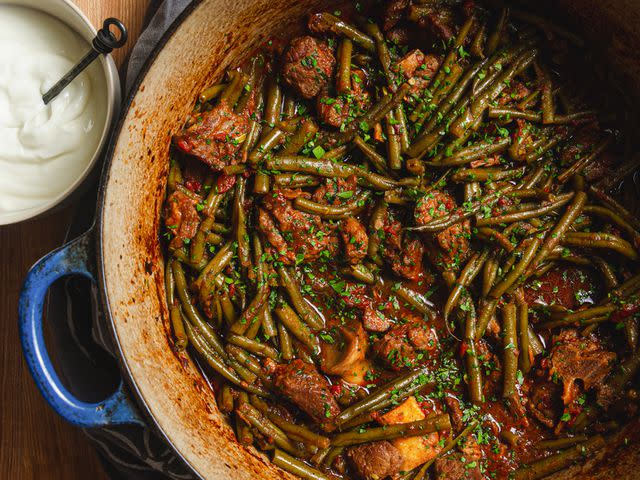
Serious Eats / Andrew Janjigian
Ganach lupia or ganach fassoulia—tomato-braised green beans—is so essential to Armenian cuisine that its name simply means “green beans” (“ganach” is Armenian for “green" and “lupia” is the Armenian word for "bean," and “fassoulia” is the Arabic word for “bean”). When an Armenian uses the term “green beans” or even just “beans,” they are referring to this dish, not the raw vegetable. (That Armenians often call the dish by its Arabic name is evidence of its ubiquity across Southwest Asia and North African. Fassoulia is one example of several tomato-braised vegetable dishes in Armenian cooking; another is bamiya, or tomato-braised okra, another key dish.
Unsurprisingly, there are countless variations. There are vegetarian versions, where beans are braised in a mixture of water and tomatoes, and meaty iterations with beef or lamb. The common denominator to all is the use of onions and garlic as base flavors, along with time. The dish is cooked for hours, until the beans (and meat, if present) are meltingly tender and deeply savory. Crisp-tender green beans are nice, but this is not that. Green beans contain a lot of lignin, the same cellulose-based compound that makes wood hard, so they need time to adequately soften, just like the meat they are partnered with.
My family often makes this dish—which we just call “fassoulia”—with lamb neck or bone-in shoulder. Though it’s definitely a hearty, “meaty” main dish, the green beans are the star. The meat is a source of umami and richness, and accompanies the beans, not the other way around.
Sini Manti
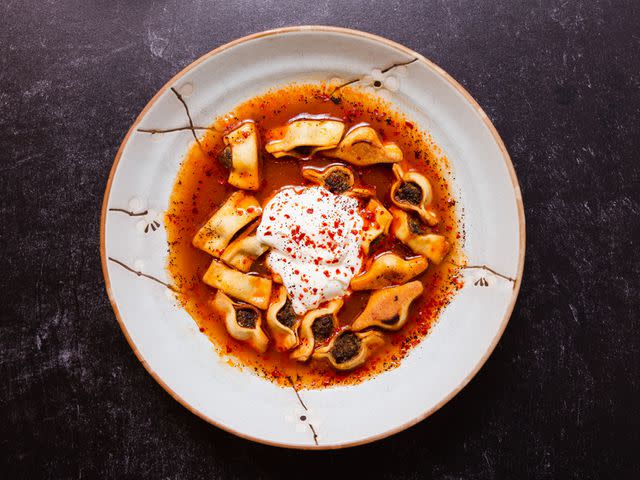
Manti—small parcels of spiced ground lamb or beef surrounded by thin wheat wrappers that are steamed or boiled—are common throughout Central and West Asian cuisines. However, Armenian manti, sometimes called sini manti, are a little different. While most other manti recipes are boiled, these tiny canoe-shaped, open-topped dumplings are first baked until crisp, then served in a rich tomato-infused lamb broth. Topped with a dollop of garlicky yogurt and a sprinkling of Aleppo pepper and sumac, it is, to me, the ultimate manti. The combination of flavors and textures is exceptional: You have crunchy, lamb-filled dumplings that have been softened gently by the steaming, aromatic broth against the cooling, tart yogurt, with spicy, aromatic, and tart garnishes that brighten each bite.
Up until recently, making and eating manti was a Christmas Eve ritual for my extended Armenian family. For weeks leading up to the holiday, the women in the family gather together to make the dumplings, which they'd then freeze. Hours, and hours, and hours of work go into making enough to feed a few dozen people the meal they look forward to all year long. Nowadays, I make manti myself when I want it, but given all the work involved, it’s a project I usually undertake just once a year. Still, it’s one I try to make time for.
Harissa
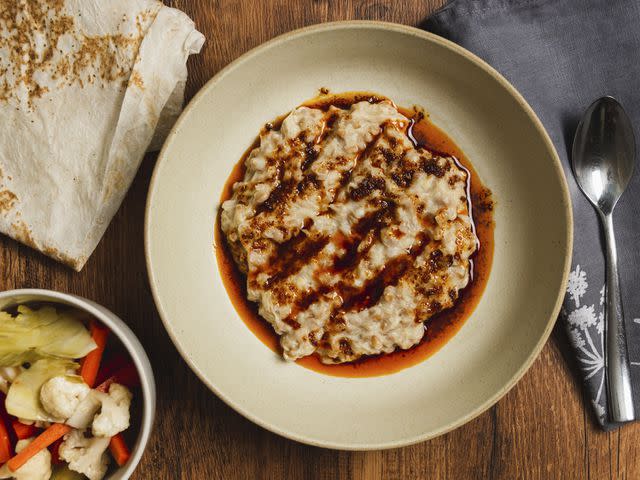
Serious Eats / Andrew Janjigian
Harissa—also known as herisseh, harisa, or keshkeg—is a wheat berry and meat porridge, and one of the world’s great (if lesser-known) cool-weather comfort foods. The meat is usually chicken or lamb, and the wheat is usually korkot, or “shelled” wheat, which are wheat berries that have had their tough hulls removed (like hulled barley), making them about twice as fast to cook. The meat and the wheat berries are combined with water or stock and stirred over low heat for hours until everything disintegrates into a uniform, stodgy porridge. While that might not sound appealing, the process transforms the simple ingredients into a satisfying, nourishing, and deeply savory whole. When topped with its mandatory Aleppo pepper–spiced browned butter, harissa absolutely sings.
Harissa is of special cultural significance to Armenians, many of whom consider it a national dish. While it is eaten year-round, particularly during the winter, it's also served at Easter to mark the end of Lent and at celebratory feasts, as for the birth of a first child. Armenians insist the dish originated in the Armenian Highlands, but versions of it are known throughout Southwest Asia and India as well. In Arabic it is known as harees, and it is a staple of Ramadan meals.
Eetch
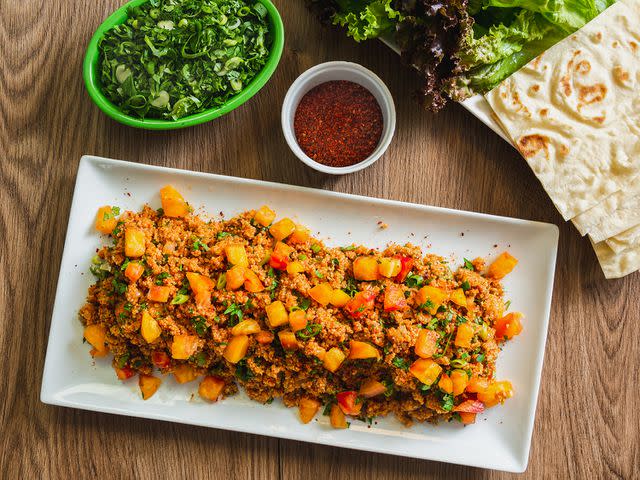
Andrew Janjigian
Eetch is a classic Armenian dish of bulgur wheat, tomatoes, and chopped green herbs. It’s often compared to tabbouleh—a Middle Eastern salad with parsley, tomatoes, mint, and bulgur wheat—but eetch isn't really a salad, as it's more moist and cohesive. And while it can be eaten with a fork, it's just as often eaten stuffed within a tender lettuce leaf or a shroud of lavash.
Eetch is one of many Armenian “meatless” meat dishes that were created as a result of the many proscriptions to meat eating handed down by the Church. It is usually served as part of an appetizer (mezze) spread, but also makes a thoroughly satisfying and quick-to-assemble one-dish meal. It’s excellent year-round, but it’s particularly delicious in the height of summer, when cool dishes are welcome and fresh herbs, lettuces, and juicy, flavorful tomatoes are easy to come by.
Dolma and Sarma
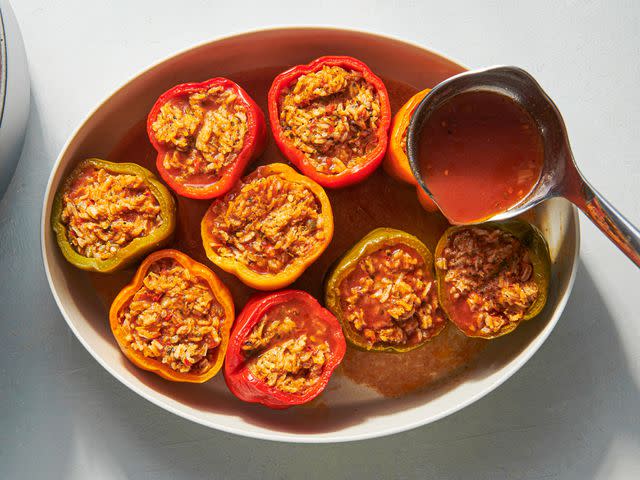
Serious Eats / Qi Ai
Sarma and dolma are really two generic names for tomato-braised rice-and-meat stuffed vegetables; the only real difference is the vegetables in question and how they are used. In Turkish, sarma means “wrapped” and dolma means “stuffed.” Both call for a hearty filling of ground meat and rice, and while sarma involves wrapping the stuffing with a leaf like that of grape or fig, dolma refers to stuffing vegetables like bell peppers, zucchini, and eggplant.
Dolma and sarma are beloved by Armenians, but the same basic dish is eaten throughout the Middle East, the Mediterranean, and Eastern Europe, and most follow a similar template. Once the vegetables are filled or used to wrap the filling, they’re placed into a large pot and braised with a savory tomato broth until the vegetables have softened and the meat and rice become juicy and tender.
Armenian dolma and sarma are essentially meatballs stuffed into or wrapped with vegetables, respectively.They are served in a pool of the braising liquid, with a dollop of cooling yogurt alongside.
Ghapama (Armenian Stuffed Pumpkin)
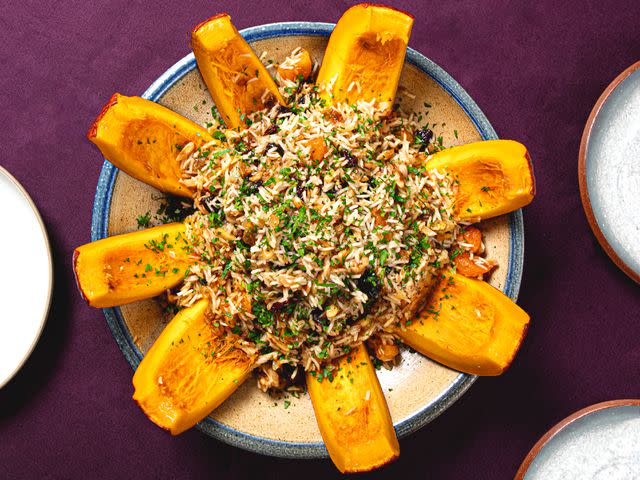
Serious Eats / Amanda Suarez
Ghapama is a baked pumpkin stuffed with a jeweled rice pilaf dotted with onions, nuts, dried fruits, and herbs. It’s a dish so cherished by Armenians that it has its own song. Titled “Hey Jan Ghapama,” the tune is about a pumpkin farmer who somehow manages to feed a crowd of a hundred family and friends with a single pumpkin. Though ghapama can’t actually feed a hundred people, it’s an excellent way to feed many. It’s a traditional celebration dish, particularly around Christmas and the new year, when pumpkins are in season. Cooks carve the pumpkin into wedges and fan it out like a flower, with the rice mounded over the center. The elegant dish looks challenging to make, but it’s actually quite easy to assemble and bake—and is as beautiful as it is delicious.
Boreks (Armenian Spinach and Cheese Turnovers)
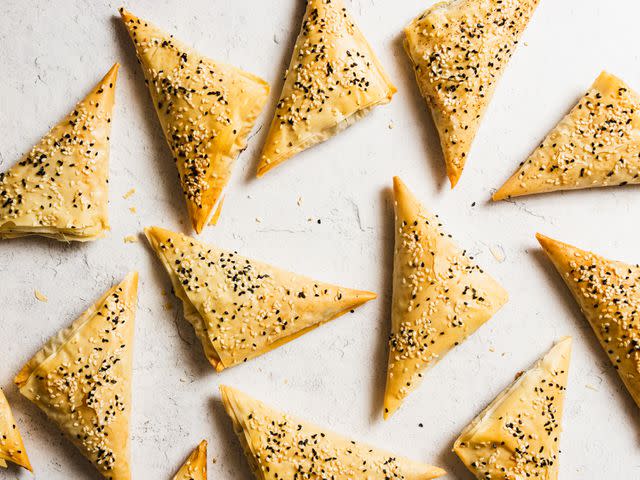
Andrew Janjigian
If you’re ever served an Armenian mezze spread, you’ll likely see cured olives, string cheese, dried apricots, walnut halves, and cured meats like basturma (cured, dried lean beef) and sujuk (spiced Armenian beef sausage), along with boreks. Boreks are crisp, flaky phyllo hand pies filled with cheese, tender greens, vegetables, meat, or a combination. They're usually made into triangle-shaped hand-pies, although some prepare tray-style boreks by baking one large-format pie in a pan, then cutting it into individual portions. Boreks are dear to Armenians, but are also equally prized throughout the countries that were once a part of the Ottoman Empire, including Albania, Bulgaria, Turkey, Greece, and Serbia.
While boreks can be made with puff pastry or yufka, a more rustic pastry dough that’s halfway between a pasta and phyllo in thickness, most Armenian boreks are made using phyllo dough. The most common fillings for Armenian boreks are either a mixture of cheeses—melty ones like Muenster or Monterey Jack, tangy feta, and something creamy, like cottage or cream cheese—or a combination of cheese and cooked, drained spinach. Herbs and alliums like parsley, dill, and scallion are common additions to either style, and eggs are usually added as a binder.
Tourshi (Armenian Pickled Vegetables)
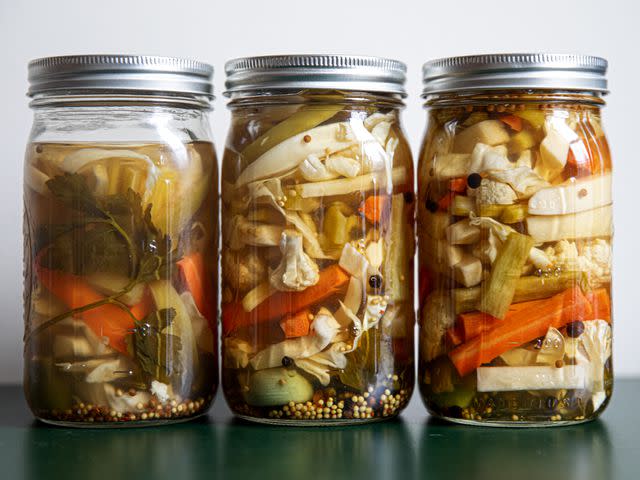
Serious Eats / Amanda Suarez
In Armenia, as well as in numerous other countries in Southwest and Central Asia, ”tourshi” just means “pickles.” You can make tourshi with just about any crisp edible-when-raw vegetable, like carrots, cauliflower, cabbage, or turnips. You can make it like sauerkraut, where the vegetables are preserved in a tart brine provided by lactic acid fermentation, but in my family, we use a tangy, vinegar brine lightly spiced with mustard, coriander, black peppercorns, and allspice berries.
Armenians set tourshi on the dining table no matter the occasion, but it is an essential component of any mezze spread or a side dish alongside entrées. Though the pickles take a few weeks to, well, pickle, it’s otherwise a quick and simple process and a great way to preserve summer’s bounty of crisp vegetables for the winter months.
Gata (Armenian Coffee Cake)
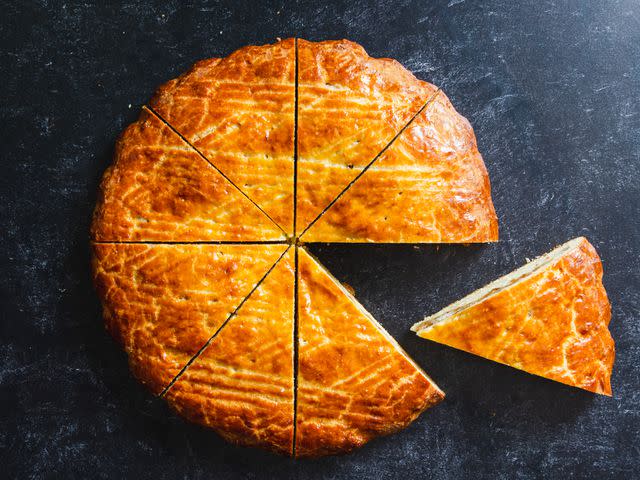
Andrew Jianjigian
Gata is a lightly sweetened, buttery Armenian cake, bread, or pastry meant to be served as part of a mezze spread, as a dessert, and/or with coffee or tea. Some gata resemble croissants or rugelach: bakers roll an enriched bread dough into paper-thin, table-wide sheets using an okhlavoo (a wooden dowel dedicated to dough work), smear it with butter, then roll it up like a carpet before cutting the dough into spirals that bake up layered and crisp. Others are sweeter and decidedly more cake-like, and the dough may be yeasted or leavened with baking soda and acidic dairy.
This latter style is usually formed into a flattened disc and filled with butter, flour, sugar, vanilla, and sometimes a chopped nut paste known as khoritz—essentially the Armenian equivalent of streusel—then folded up and gently rolled into an even 9-inch round. These more simple gata are often dressed up with decorative strips of dough or by scoring patterns onto the top before baking. This version is simple and relatively quick to make, and absolutely delicious served at any time of day.
Where to Go From Here
This obviously isn’t an exhaustive list of essential Armenian recipes, but is a starting point if you’re interested in learning more about the cuisine. Other crucial recipes to consider include tanabour, the silky yogurt-and-barley soup that’s eaten both cold and hot, depending upon the season. There’s vospov kofte, which are vegetarian patties made from bulgur and softened red lentils that are often eaten during Lent, when the church forbids the consumption of meat. Another delicious Lenten dumpling is topik, which are potato-and-chickpea patties stuffed with onions, pine nuts, currants, sesame paste, and spices.
For desserts and sweets, there’s tahinovhats, a flaky laminated flatbread layered with sugar, tahini paste, and warm spices that is baked until crisp. And anoush abour, a pudding-porridge, made with wheat berries, dried fruit, and nuts, is traditionally served to celebrate the New Year. Or burma, which are buttery, crisp, crinkled phyllo-wrapped logs, filled with sweetened ground walnuts, soaked in sugar syrup.
No matter which Armenian recipes you choose—humble and filling, or rich and decadent, or both—it’s sure to be a celebration.
Read the original article on Serious Eats.






